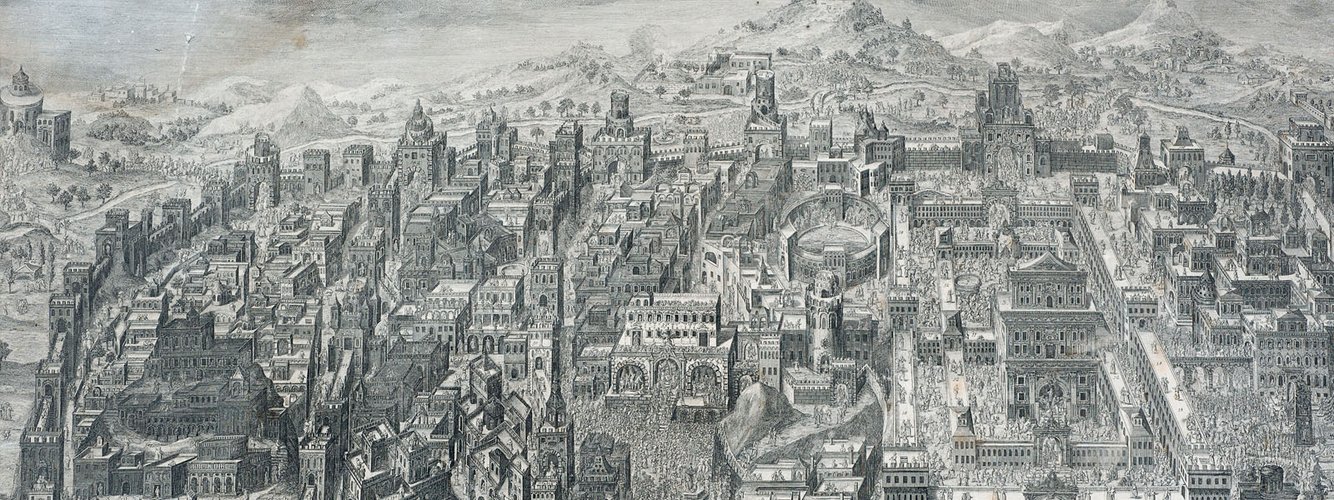


C. 1182
Under the sponsorship of Margrave Heinrich von Ronsberg, a Benedictine abbey develops from an anchorite community in the Eiberg Forest. The convent finds its first home on the Irsee castle hill.
1190 – 1195
The church and the abbey are newly constructed at the foot of the hill, at the current location.
1209
Innocent III places the abbey under papal protection.
13th century
Papal, royal and episcopalian documents confirm the rights and territories of the monastery.
13th – 16th century
From acquisitions and gifts, the abbey develops a dominion along with the villages of Irsee, Eggenthal, Baisweil, Lauchdorf, Schlingen, Ketterschwang, Rieden, Pforzen, Leinau and Mauerstetten and the dwellers therein.
1416
After a fire, the choir stalls, the spire and probably also the monastery building is rebuilt.
Late 15. / Beginning 16. century
Irsee Monastery is subordinate directly to the Kaiser.
1525
Rebel farmers devastate the abbey.
Around 1600
Particularly under abbott Carolus Andreae, cultivation of music in Irsee begins.

1632 – 1648
The abbey and its subjects suffer heavily under the plunderings, pillages and extortions of the 30 Years’ War.
End of 16. to end of 17. century
The Monks of Irsee increasingly receive scientific education in other monasteries and universities.
1692/94
Irsee receives jurisdiction over life and death in its dominion and now exercises full sovereignty over the land.
1699 – 1735
After the collapse of spire and nave, the monastery was almost completely rebuilt under abbott Willibald Grindl and his successor Bernhard Beck, with assistance of master builder Franz Beer, also of the Irsee lay brother Magnus Remy and numerous other prominent artists. 1699 – 1702, the church of the cloister and 1707 – 1711 the north-, east- and southern wing of the monastery building are constructed. The Sommerhaus in the prelate garden is built 1714, the west wing of the monastery mounts after an interruption from 1727 – 1735. An ideal planning with mirror symmetric construction surrounding the monastery church has never been realized.
18th century
Irsee Monastery is considered as most important location for science and music cultivation among monasteries in southern Germany. Father Ulrich Weiß teaches mathematics in Irsee, Father Meinrad Spieß is publishing several extensive compositions. The mathematical-natural scientific museum, established in 1744, enjoys high esteem. Moreover, members of the Irsee convent work as teachers in other monasteries and universities.
1802/03
Irsee Monastery is dissolved as part of the Secularisation. All possessions except the monastery building are sold. Thereafter, the building houses a regional court, a bursary, a forester office and a priest.
1849
After a long period of planning and reconstruction, the first Swabian district asylum is opened in 1830; after an asylum in Erlangen, the second modern asylum in Bavaria. New and more human methods of treatment were introduced. As of the beginning, the new asylum struggles with unsuitable space and the hospital is soon overcrowded.
1876
After not realized plans of extension, the Irsee institute becomes a department of the new District, Curative and Care Institute in Kaufbeuren. Having finished a renovation, in Irsee a new "house for unruly women" (today studio building) and the Pathology were erected. In the afermath, Irsee develops to a mere place of isolation for chronically ill patients.
1933 – 1945
After initial improvements in methods of treatment, sterilisations by constraint were following during the national-socialistic rule and as of 1940, also targeted homicide of patients in Kaufbeuren-Irsee: up to 1.600 people of both parts of the asylum, women, men and children, were deported in the wake of NS-"Euthanasia" in extermination camps, die as consequence of "starvation diet" or are killed directly by means of overdoses of medicines. In the Pathology , the corpses were dissected and death certificates were falsified. Because of the numerous dead, an asylum graveyard was created in 1944.
1949
The director of the institution and several nursing staff are convicted to short imprisonements.
1972
The Irsee department for the mentally ill is dissolved. The last patients leave the asylum.
1974
The Swabia district assembly decides on the restoration of the abbey complex and the new purpose as an educational centre in a return to the tradition of Benedictine intellectuality. Due to the extended period of asylum use, also the education in psychatry is being focused. Nearly all traces of the asylum's history disappear as a side effect of the restoration.
1981
The Irsee Monastery Swabian Conference, Educational and Cultural Centre opens its doors. It also houses the institutions Schwabenakademie and the Bildungswerk des Bayerischen Bezirketags. The focus of the educational centre is professional education and ambitious events in music, literature and visual arts.
Great efforts are made in the monastery's history research, the asylum and the commemoration of the euthanasia victims: several places of remembrance, the promotions of publications and also the releases of Irsee renaissance music records and compositions of Meinrad Spieß.
Dr. Gerald Dobler
Dienste in Kunst- und Denkmalpflege, Wasserburg/Inn